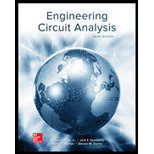
(a)
Find the voltages
(a)
Answer to Problem 44E
The values of voltages
Explanation of Solution
Given data:
Refer to Figure 13.64 in the textbook for the given circuit.
Formula used:
Write the expression for transformer ratio in terms of voltages as follows:
Here,
Write the expression for equivalent resistance of secondary winding when the transformer is referred to the primary winding as follows:
Here,
Calculation:
Consider left side transformer as first transformer and right side transformer in the given circuit as second transformer to obtain the required objectives.
From the given source current, write the maximum value of current
From the given circuit, the transformer ratio for two transformers are written as follows:
Use the current division rule, the expression in Equation (2), and write the expression for current through
Substitute
From the given circuit, write the expression for current through
Substitute
From the given circuit, write the expression for voltage across primary winding of the first transformer as follows:
Substitute
Use the expression in Equation (1) and write the expression for voltage across secondary winding of the first transformer as follows:
Substitute
From the given circuit observe the dot convention and write the expression for
Substitute 0.687 V for
Use voltage division rule, expression in Equation (2), and write the expression for voltage across primary winding of the second transformer as follows:
Substitute
From the given circuit, write the expression for
Substitute
Conclusion:
Thus, the values of voltages
(b)
Find the average power delivered to each resistor in the given circuit.
(b)
Answer to Problem 44E
The average power delivered to
Explanation of Solution
Formula used:
Write the expression for average power delivered to resistor as follows:
Here,
Calculation:
From Part (a), the voltage across
Substitute
Write the expression for voltage across
Substitute
Write the expression for voltage across
From Part (a), substitute
Write the expression for voltage across
From Part (a), substitute
Modify the expression in Equation (3) to obtain the average power delivered to
Substitute 3.483 V for
Modify the expression in Equation (3) to obtain the average power delivered to
Substitute 0.04742 V for
Modify the expression in Equation (3) to obtain the average power delivered to
Substitute
Modify the expression in Equation (3) to obtain the average power delivered to
Substitute
Conclusion:
Thus, the average power delivered to
Want to see more full solutions like this?
Chapter 13 Solutions
Engineering Circuit Analysis
- Calculate the equivalent impedance of a circuit in which a coil of wire having a value of 5∠53.2ºohm is connected in parallel with a capacitive reactance of 6.25 ohms.arrow_forwardCalculate the equivalent impedance of a circuit where a coil of (5H, angle 53.2 Deg.) ohms is connected in parallel with a capacitive reactance of 6.25 ohms.arrow_forwardA coil has a resistance of 4 and an inductance of 9.55 mH. Calculate (a) the reactance, (b) the impedance, and (c) the current taken from a 240V, 50 Hz supply. Determine also the phase angle between the supply voltage and currentarrow_forward
- An Electrical engineer is asked by a client to prepare a technical specification on specific items connected with a project. Hence, the engineer is requested to prepare the technical specification of the following: PROJECT: A Subdivision Development Lot AREA; 2 Hectares LOCATION: Brgy. Kanlurang Mayao, Lucna City Technical specification of fuse cutout Technical specification of transformerarrow_forwardA 2,400/480-V rms step-down ideal transformer delivers 50 kW to a resistive load. Calculate:(a) the turns ratio(b) the primary current(c) the secondary currentarrow_forwardA resistor of 6 ohms and an unknown impedance coil in series draws 12 A from a 120 V, 60 Hz line. If the real power taken from the line is 1152 Watts, what is the coil inductance?arrow_forward
- Kindly answer A coil has an inductance of 40 mH and negligible resistance. Calculate its inductive reactance and the resulting current if connected to (a) a 240V, 50 Hz supply, and (b) a 100V, 1 kHz supplyarrow_forwardA rogue technician working on a live 480 VAC service panel drops a wrench resulting in phase to phase short. Calculate the resulting current if the Thévenin equivalent resistance is 10 mΩ and the wrench has a resistance 30 mΩ.arrow_forwardFor a star connection network, consuming power of 1.8kW and power factor 0.5, compute the inductance and resistance of each coil at a supply voltage of 230 Volts, 60 Hzarrow_forward
- A coil of inductance 318.3 mH and neg[1]ligible resistance is connected in series with a 200 resistor to a 240V, 50 Hz supply. Calculate (a) the inductive reactance of the coil, (b) the impedance of the circuit, (c) the current in the circuit, (d) the p.d. across each component, and (e) the circuit phase anglearrow_forwardA resistance of 16 Ω is connected in series with a pure inductance of 39.9 mH and the circuit is connected to a 100 V, 50 Hz, sinusoidal supply. Calculate the phase angle of the impedance. Give your answer as a number without units to 0 decimal places.arrow_forwardCalculate the energy stored in the coupled coils at t = 10 ms if M = 0.2 H and vs = 12 cos 10t V.arrow_forward
 Introductory Circuit Analysis (13th Edition)Electrical EngineeringISBN:9780133923605Author:Robert L. BoylestadPublisher:PEARSON
Introductory Circuit Analysis (13th Edition)Electrical EngineeringISBN:9780133923605Author:Robert L. BoylestadPublisher:PEARSON Delmar's Standard Textbook Of ElectricityElectrical EngineeringISBN:9781337900348Author:Stephen L. HermanPublisher:Cengage Learning
Delmar's Standard Textbook Of ElectricityElectrical EngineeringISBN:9781337900348Author:Stephen L. HermanPublisher:Cengage Learning Programmable Logic ControllersElectrical EngineeringISBN:9780073373843Author:Frank D. PetruzellaPublisher:McGraw-Hill Education
Programmable Logic ControllersElectrical EngineeringISBN:9780073373843Author:Frank D. PetruzellaPublisher:McGraw-Hill Education Fundamentals of Electric CircuitsElectrical EngineeringISBN:9780078028229Author:Charles K Alexander, Matthew SadikuPublisher:McGraw-Hill Education
Fundamentals of Electric CircuitsElectrical EngineeringISBN:9780078028229Author:Charles K Alexander, Matthew SadikuPublisher:McGraw-Hill Education Electric Circuits. (11th Edition)Electrical EngineeringISBN:9780134746968Author:James W. Nilsson, Susan RiedelPublisher:PEARSON
Electric Circuits. (11th Edition)Electrical EngineeringISBN:9780134746968Author:James W. Nilsson, Susan RiedelPublisher:PEARSON Engineering ElectromagneticsElectrical EngineeringISBN:9780078028151Author:Hayt, William H. (william Hart), Jr, BUCK, John A.Publisher:Mcgraw-hill Education,
Engineering ElectromagneticsElectrical EngineeringISBN:9780078028151Author:Hayt, William H. (william Hart), Jr, BUCK, John A.Publisher:Mcgraw-hill Education,





